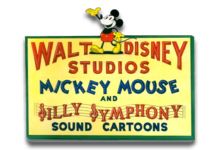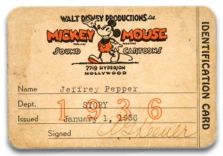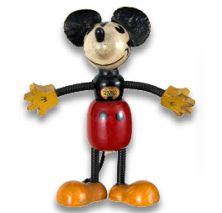From the book California Crazy and Beyond by Jim Heimann
Programmatic architecture, more commonly referred to as "California Crazy," was a visual mainstay along the roads and highways of southern California for much of the early half of the 20th century. It was not surprising then when Disney cartoon makers drew inspiration from programmatic design when creating the 1949 Donald Duck short All in a Nutshell.
 In the cartoon, Donald Duck is the proprietor of a roadside stand called Don's Nut Butter. Shaped like a giant walnut, the stand is not just simply
In the cartoon, Donald Duck is the proprietor of a roadside stand called Don's Nut Butter. Shaped like a giant walnut, the stand is not just simply a background element--it is the gag that propels the story. Coveting this huge "nut," Chip and Dale set about attempting to crack its shell. When they breech an opening near the top, they discover its non-organic nature, but then decide to instead dedicate their efforts to pirating off as much of the duck's nut butter as they can possibly manage.
a background element--it is the gag that propels the story. Coveting this huge "nut," Chip and Dale set about attempting to crack its shell. When they breech an opening near the top, they discover its non-organic nature, but then decide to instead dedicate their efforts to pirating off as much of the duck's nut butter as they can possibly manage. Don's giant walnut was inspired by numerous roadside establishments that were typically produce stands or counter service cafes. Very similar in appearance and style to the Nut Butter stand was the Jumbo Lemon, one of a chain of drink stands with locations throughout California. Other notable examples included the Chili Bowl, the Mushroom Cafe and the Tamale, all small diners that sprang up in southern California during the 1920s and 1930s.
Don's giant walnut was inspired by numerous roadside establishments that were typically produce stands or counter service cafes. Very similar in appearance and style to the Nut Butter stand was the Jumbo Lemon, one of a chain of drink stands with locations throughout California. Other notable examples included the Chili Bowl, the Mushroom Cafe and the Tamale, all small diners that sprang up in southern California during the 1920s and 1930s. Two years prior to All in a Nutshell, Disney animators made reference to one of the most famous examples of programmatic architecture, in the 1947 feature film Fun and Fancy Free. At the end of film, Willie the Giant is seen walking through the Hollywood landscape, searching for a "teensy-weensy little mouse." He spies the famous bowler hat architecture of the Hollywood Brown Derby
Two years prior to All in a Nutshell, Disney animators made reference to one of the most famous examples of programmatic architecture, in the 1947 feature film Fun and Fancy Free. At the end of film, Willie the Giant is seen walking through the Hollywood landscape, searching for a "teensy-weensy little mouse." He spies the famous bowler hat architecture of the Hollywood Brown Derby Restaurant, picks it up and places it on his head. This very funny and then quite topical gag poked fun at the original Hollywood Brown Derby on Wilshire Avenue and its over the top California Crazy design.
Restaurant, picks it up and places it on his head. This very funny and then quite topical gag poked fun at the original Hollywood Brown Derby on Wilshire Avenue and its over the top California Crazy design.When Disneyland opened in 1955, it could be said that it was in many ways an extension of California Crazy, taken to a much more sophisticated level of design and execution. But the Walt Disney Company would in fact revisit programmatic architecture in the style's more historic context when, in 1989, the company recreated an idealistic golden age of Hollywood as part of the theming for Disney-MGM Studios. Included in the park's initial design were two very distinct homages to 1930s era California Crazy motifs. Both were located into the Echo Lake area of park; both were counter service food establishments (as were the vast majority of vintage-era programmatic buildings), and they both bore thematic connections to early Hollywood productions.
 Dinosaur Gertie's Ice Cream of Extinction paid homage to the star of Windsor McKay's landmark animated cartoon from 1914. Dinosaurs have long been a popular subject for novelty architects and Gertie is similar in design and scale to other roadside dinosaur structures. Other creature-inspired establishments ran the gamut from dogs and chickens to pigs and fish.
Dinosaur Gertie's Ice Cream of Extinction paid homage to the star of Windsor McKay's landmark animated cartoon from 1914. Dinosaurs have long been a popular subject for novelty architects and Gertie is similar in design and scale to other roadside dinosaur structures. Other creature-inspired establishments ran the gamut from dogs and chickens to pigs and fish.Min and Bill's Dockside Diner was inspired by the 1930 film Min and Bill starring Wallace Berry and Marie Dressler. Imagineers drew on the movie's waterfront setting to create the counter service venue that takes the form of a vintage tramp steamer. Nautical design was an especially popular theme of California Crazy, distinguished typically by land-bound ships, boats and even inspired interpretations of Noah's Ark.
In an interesting, and somewhat ironic twist, Imagineers did not reproduce the original bowler hat design when they recreated the Hollywood Brown Derby Restaurant at the Studios park. Instead they based the signature eatery's design on the Hollywood Brown Derby location that was built near the intersection of Hollywood and Vine. But Imagineers did recreate the storefront facade of the Darkroom, a well known Hollywood retail store, for the park's own camera shop on Hollywood Boulevard. And it certainly could be argued that the oft-debated giant Sorcerer's Hat that has become the icon of the Studios is but another shining example of programmatic architecture.
 One final interesting Disney-California Crazy connection to make note of: comics writer-illustrator Dave Stevens incorporated one of the more famous programmatic structures, the Bulldog Cafe, into his graphic novel The Rocketeer. Disney recreated the cafe when it adapted the work into a film in 1991, and that particular set piece resided for a number of years on the back lot at Disney-MGM Studios. The original Bulldog Cafe dated back to the 1920s and was located on West Washington Boulevard in Los Angeles. A very similar building, called the Pup Cafe, was a popular hot dog stand and served the citizens of Venice, California during the early 1930s.
One final interesting Disney-California Crazy connection to make note of: comics writer-illustrator Dave Stevens incorporated one of the more famous programmatic structures, the Bulldog Cafe, into his graphic novel The Rocketeer. Disney recreated the cafe when it adapted the work into a film in 1991, and that particular set piece resided for a number of years on the back lot at Disney-MGM Studios. The original Bulldog Cafe dated back to the 1920s and was located on West Washington Boulevard in Los Angeles. A very similar building, called the Pup Cafe, was a popular hot dog stand and served the citizens of Venice, California during the early 1930s.Screenshots © Walt Disney Company



















8 comments:
Great post Jeff. I love the short ALL IN A NUTSHELL and the book CALIFORNIA CRAZY. These crazy, kitschy architectural structures brought a bit of cartoon whimsy to the real world.
How fun!
Wow - I never knew any of this stuff! I love to know the inspiration behind the things we have come to know and love
Hey, when I first saw that big almond shell a flood of memories from my brother and I's childhood came back. We loved Chip and Dale, and especially that cartoon short. Do you have a higher resolution of that picture? Thanks
*sigh* I've always said that everyone else had it easy. All we had in New York City were the skyscrapers and the subway. I feel so deprived.
Well, peter fay, the East Coast wasn't entirely bereft of "California" crazy architecture. Long Island has the "BIg Duck" http://www.roadsideamerica.com/attract/NYFLAduck.html
Great post, Jeff!
I think it is wonderful that there is that throw back to great times in American history through out the parks. That donald short that you featured is definitely one of my favorites. Great post and keep them coming. Also, I have recently started a blog myself if you would care to visit. Thanks from one Jeff to another.
The restauraunt was named the Brown Derby, not the Hollywood Bowl. See here.
That was an incredible brain misfire that carried through the entire article. Wow. I think I'm gonna need to get an editor . . .
Thanks for catching it and letting me know.
Post a Comment